The University of Tokyo as Art Exhibition A roundtable commentary by three researchers on major works in campus collections

The University of Tokyo as Art Exhibition
A roundtable commentary by three researchers on major works in campus collections
From the murals in Yasuda Auditorium to works by Marcel Duchamp; from paintings regarded as National Treasures to underwear!
We asked three faculty members engaged in fine arts research to choose some of the most important works from among those prominently displayed in various locations across the UTokyo campuses, and to comment on them in the form of a roundtable discussion. They tell us about what was immediately evident, what was apparent only in outline, and what was utterly hidden from view. Taking another look at these works of art while reading over the text of this discussion reveals UTokyo to be an art gallery like no other.
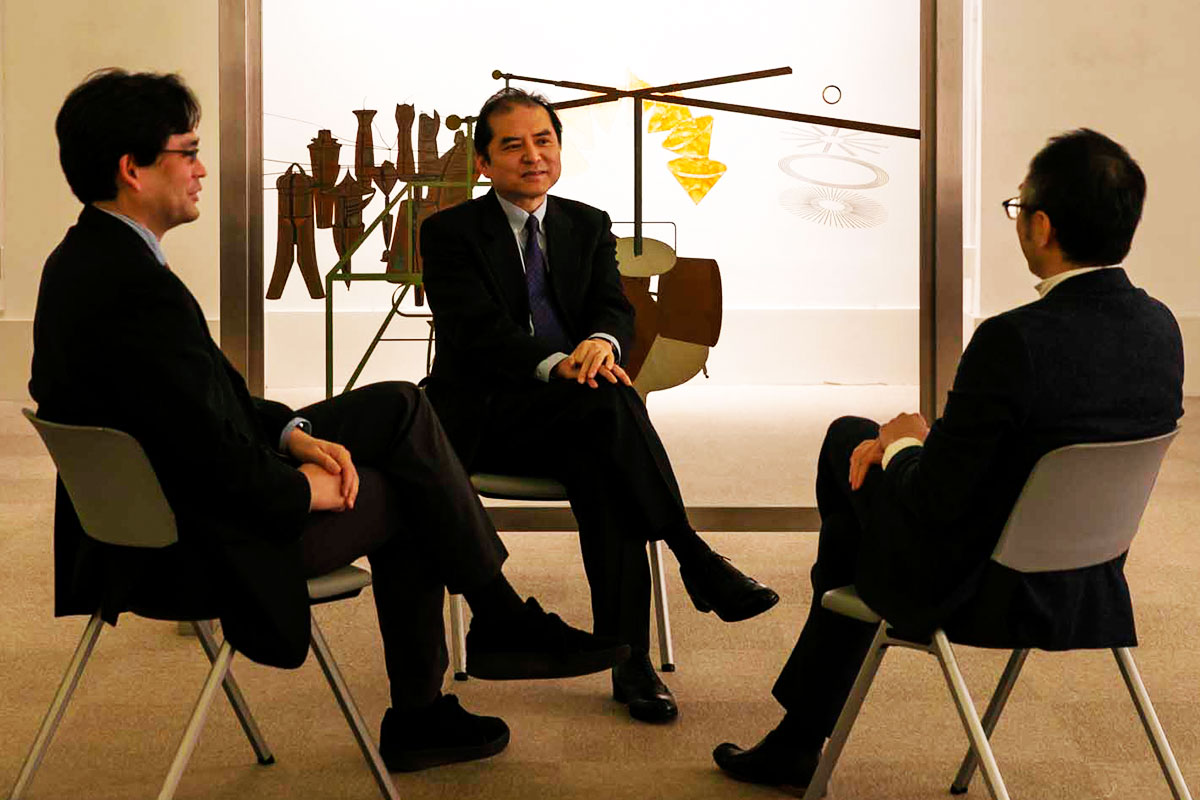
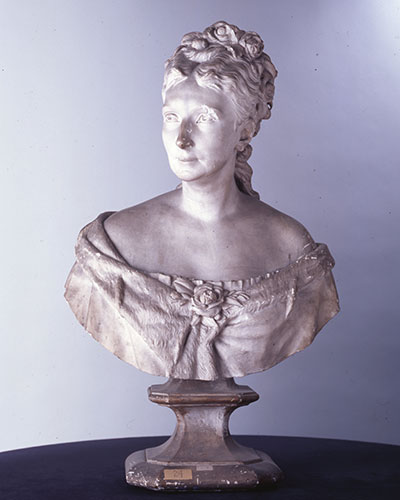
Vincenzo Ragusa
Mrs. Keller
1878, Graduate School of Engineering
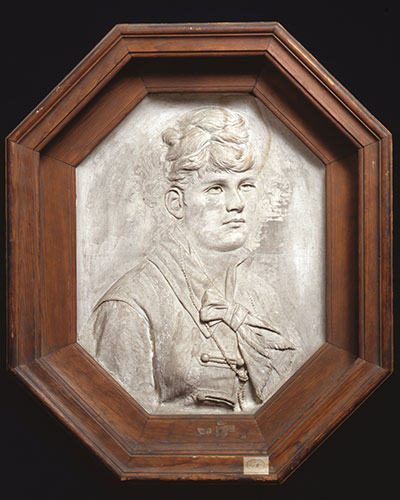
Vincenzo Ragusa
Bust Relief in Octagonal Frame
Undated, Graduate School of Engineering
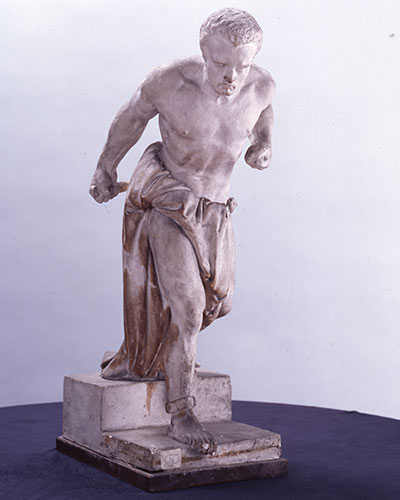
Ujihiro Okuma
Jailbreak
1882, Graduate School of Engineering
The fruits of western art education in the Meiji period
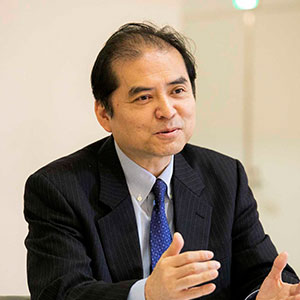
- Miura Among the foreign advisers invited to the Kobu Bijutsu Gakko (the “Technical Fine Arts School” attached to the Imperial College of Engineering, a predecessor of the University of Tokyo) was Vincenzo Ragusa, who was placed in charge of sculpture. At that time, teaching sculpture focused on imitation, and it was important for the student to copy a model faithfully. 01 and 02 are sculptures produced by Ragusa modeled on Westerners and that were used as models for his students, and while I would not go as far as to say that they are masterpieces, they give the sense of being solidly accomplished.
- Takagishi I would add that this bust style of portrait sculpture representing the subject from the chest up was a form that had been fairly rare in Japan until then.
- ―― So was Ragusa a first-class sculptor, then?
- Miura A competitive exhibition was held in Italy to select someone as a foreign adviser for Japan. Ragusa took top honors, so naturally I suppose he was top-notch. He was 35 years old when he came to Japan, so he would have been a promising young artist.
- Kajiya There’s a record of him winning the top prize at an Italy-wide fine arts exhibition held in Milan, so he was certainly very capable.
- Miura Ujihiro Okuma was the most outstanding of Ragusa’s disciples. 03 is quite a commendable work, wouldn’t you say?
- Kajiya This was his graduation piece, modeled on Spartacus by the sculptor Vincenzo Vela, who was active in Italy in the nineteenth century. Okuma subsequently worked as an assistant in the sculpture department. Spartacus was a gladiator and leader of a slave rebellion in ancient Rome. You can see that he has a short sword in his right hand and a shackle on his right ankle.
- Miura After graduating at the top of his class at the Kobu Bijutsu Gakko, Okuma studied overseas in Rome, and after his return to Japan sculpted the statue of Omura Masujiro at Yasukuni Shrine. That statue is regarded as the first Western-style bronze statue in Japan.
- Kajiya Apparently, Okuma studied anatomy under Professor Taguchi Kazuyoshi at the University of Tokyo Faculty of Medicine.
- Miura I suppose this wonderfully dynamic representation may owe something to that experience.
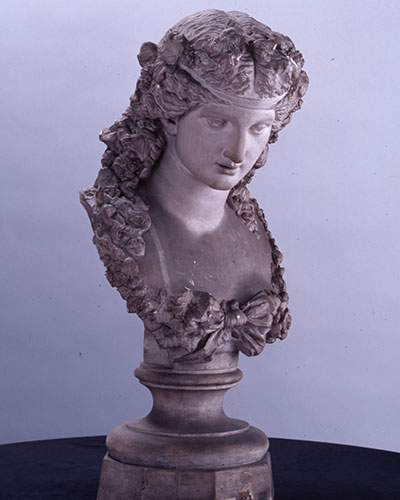
Reiyu Oguri
Ariadne: a European Woman (bust)
1879, Graduate School of Engineering
- Kajiya Next is Reiyu Oguri. I would say that 04 resembles Alias, the plaster bust of Ariadne often used as an examination piece at fine arts universities.
- Takagishi But Alias is simpler, without these ornaments on the chest. The sense of volume in the curled hair, and the sharpness of the carving are impressive – one gets the feeling of the sculptor showing off his technical skills.
- Miura It might even be a little too showy as a work of art...
- Takagishi It could also be an indication that the sculpture department at the Kobu Bijutsu Gakko placed an emphasis on technical skill.
- Miura 05 is an extremely detailed drawing. Sachihiko Soyama studied mainly under Achile San Giovanni at the Kobu Bijutsu Gakko. This seems like a product of the guidance of a master who emphasized drawing.
- Takagishi It almost seems like a photograph, doesn’t it? There is a metallic luster in places, like the highlights on the hakama.
- Kajiya The actual work measures 181cm by 123cm, so it’s really quite a large drawing.
- Takagishi I wonder if it feels more like a photograph because we’re seeing it at a reduced size.
- Miura I feel that the Kobu Bijutsu Gakko emphasized photorealism.
- Takagishi I get the sense that the artist focused more attention on the clothes and the sword than on the body. Is the musculature from the shoulders to the chest represented in a Western style?
- Miura The chest is thin and a little scrawny, which seems to me like a Japanese sensibility.
- Kajiya The subject’s pose drawing the bow reminds me of Antoine Bourdelle’s Hercules the Archer (1909). Although Soyama’s work predates his.
- Takagishi I feel this strikes an eclectic balance of mixed Western and Japanese characteristics.
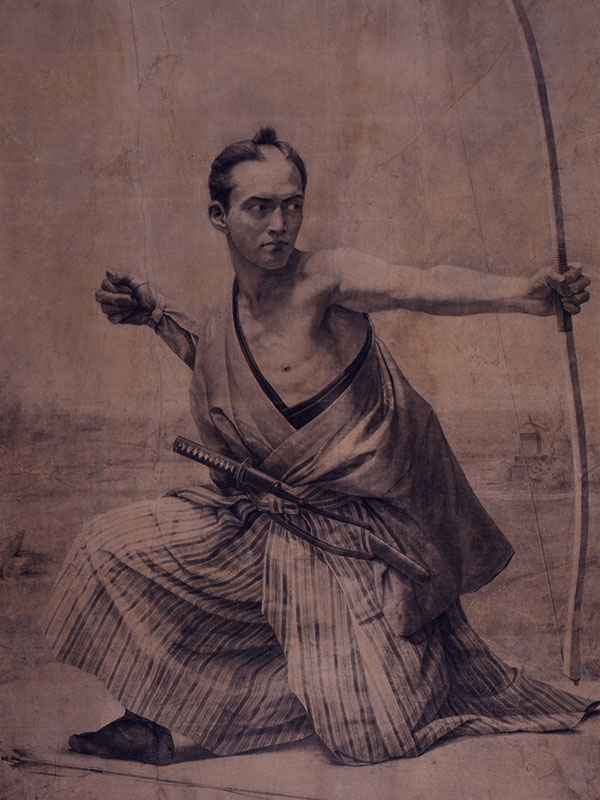
Sachihiko Soyama
Kyujutsu no Zu [Archery Study]
1881, Graduate School of Engineering
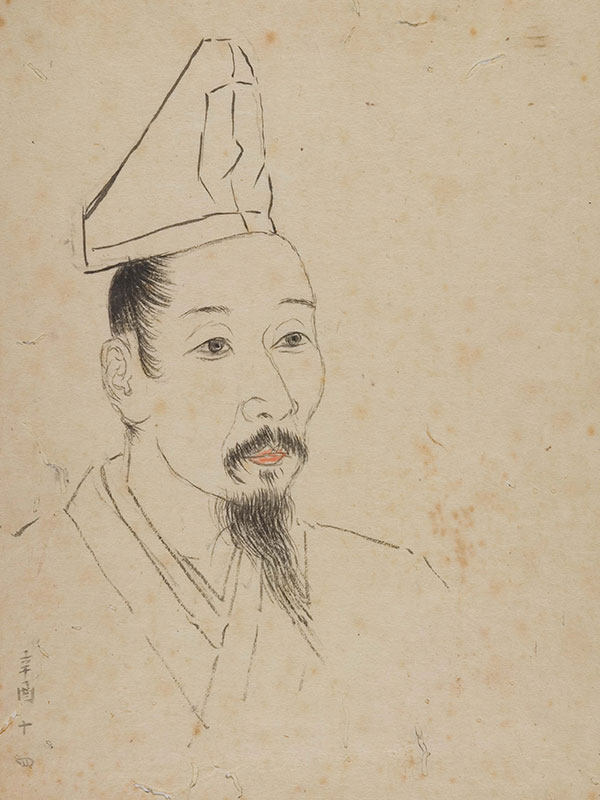
Tosa Mitsunobu
Sanjonishi Sanetaka-zo kamigata [Sketch for a portrait of Sanjonishi Sanetaka]
1501, Historiographical Institute
A window on history through the paintings of the Historiographical Institute
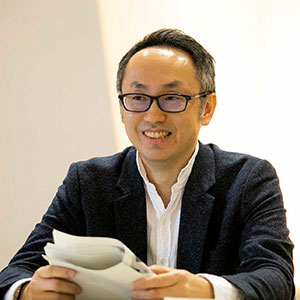
- Takagishi 06 has a notation reading “kanoto tori” in the lower left, which corresponds to the fifty-eighth year of the sexagenary cycle, followed by Chinese characters for “ten” and “four.” This tells us that the piece was painted on the fourth day of the tenth month of 1501. This kind of base sketch for a portrait is referred to as a kamigata. Sanetaka was a preeminent scholar in the Muromachi period. He left a diary spanning sixty years, the Sanetaka Koki, which also describes the background of this picture. He had invited the painter Tosa Mitsunobu to his residence to discuss plans for creating an illustrated scroll depicting the miraculous origins of the Kitano Tenjin shrine, on which occasion he proposed that Mitsunobu might paint his portrait as well. This was the sketch that Mitsunobu produced on the spot in response to the suggestion. Normally from this point the painter would begin work on a full portrait. But the entry in the diary reads “Not enough semblance” followed by the word hikyo, which could mean either “interesting” or “loss of interest,” but in this case probably means the latter.
- Miura One supposes he wanted to be depicted in a more flattering light.
- Takagishi In the end, Mitsunobu left him with just the sketch, which Sanetaka placed between the pages of a book he was reading. It stayed there until it came to the Historiographical Institute, which was buying up materials discovered by chance between the pages of old books. The date of 1501 makes this contemporary with Leonardo da Vinci; the picture suggests that sketches approximating a Renaissance style existed around this time in Japan as well. Incidentally, the University of Tokyo and Harvard are the only universities worldwide to hold original works by Mitsunobu.
- ―― And here I thought it was just a simple sketch...
- Miura With finished works, the sketches don’t survive. As such, it’s invaluable.
- Takagishi After the Historiographical Institute made a bulk purchase from the Shimazu family of documents from the clan’s archives, the entire collection was designated a National Treasure in 2002. 07 is from a series of paintings of famous sites in the Satsuma region that was included in the collection. In the nineteenth century, it became popular for painters to travel to various locales to paint them, and I believe this picture also falls into that category. As well as documenting the territory governed by the Shimazu clan, the intention here would have been to celebrate and idealize the beauty of the local landscape.
- Miura I’d say the impression conveyed is more geographical than artistic.
- Takagishi 08 is a study of a lotus flower that bloomed in a pond at the Edo residence of Mizoguchi Naoaki, the former lord (daimyo) of Shibata Domain, in 1854. The Edo period saw many daimyo who were fond of painting. The arrival of encyclopedias from the Netherlands led to the popularization of an interest in natural history, and in many cases apparently prompted daimyo to take up brushes themselves. However, this painting is lacking in Western elements and features traditional brushwork. At the end of the feudal period, Western forms of representation were taken for granted, so I believe that this painting might represent a return to a form of painting expression not characterized by verisimilitude.
- Miura The lotus flower also connotes Buddhist associations, does it not?
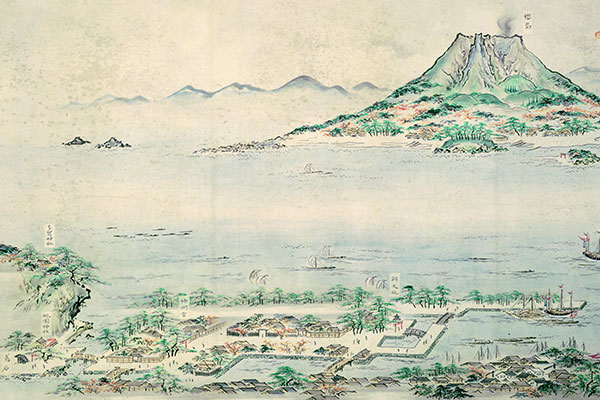
Sappan Shokei Hyazku-zu [One Hundred Scenic Views of Satsuma Domain], a National Treasure from the Shimazu-ke Monjo Archive
1815, Historiographical Institute
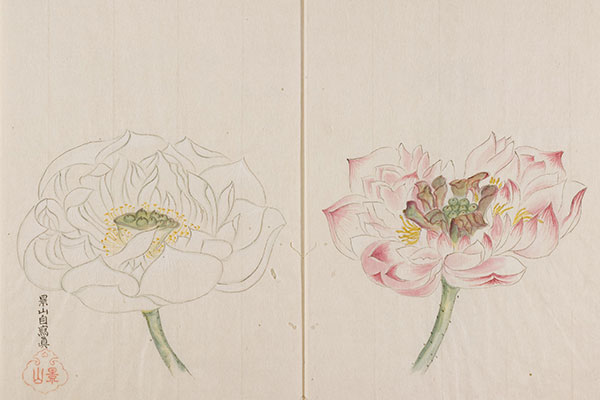
Mizoguchi Naoaki Botan Hasu Zusetsu [Illustration of Peony and Lotus]
1854, Historiographical Institute
| Support the Historiographical Institute
Steady and significant financial resources are necessary for the conservation and restoration of historical documents, which are an important part of Japan’s cultural heritage, as well as for digitization and database development. Thank you for your support. http://utf.u-tokyo.ac.jp/project/pjt10.html |
Works demonstrating connections between mathematics and art
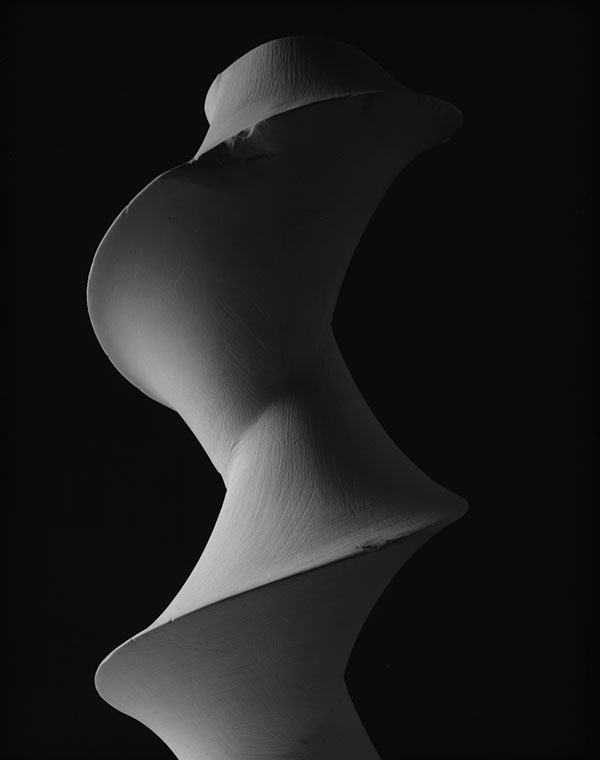
Hiroshi Sugimoto Mathematical Form: Surface 0003
2004, Graduate School of Mathematical Sciences
©Hiroshi Sugimoto / Courtesy of Gallery Koyanagi
- Kajiya The Graduate School of Mathematical Sciences possesses a suite of plaster mathematical models fabricated in Germany from the end of the nineteenth to the beginning of the twentieth centuries. The models are visual renderings of mathematical surfaces, and the University of Tokyo’s collection is one of the most complete, along with that held by the University of Göttingen in Germany. The photographer Hiroshi Sugimoto has been developing works in which he takes black and white photographs of models such as museum dioramas or wax sculptures, and 09 is one of these. Although the actual model is small, it feels enormous when seen in the photograph. Many artists have taken an interest in geometric models, including figures such as Max Ernst, Man Ray, Naum Gabo and Antoine Pevsner.
- Miura The play of light and shadow is very strong, with extreme emphasis on realizing a three-dimensional effect.
- Kajiya Mathematical models reproduced with contemporary technology by the firm Yamada Seiki in partnership with the Graduate School of Mathematical Sciences are on display at the Graduate School of Mathematical Sciences as well as in the foyer of a commercial facility in the Omotesando area of Tokyo designed by Sugimoto. One readily sees how the exquisite shapes of mathematical formulae attract artists’ attention.
- Miura I feel that Sugimoto’s works have something in common with the conceptual art of Marcel Duchamp.
- Kajiya The concept underlying 10, entitled Utsurohi, dates from an exhibition held in Paris in 1978. Initially, brass plates were used in lieu of wires. This is Miyawaki’s signature piece, also held in other collections, such as at the Museum of Modern Art, Gunma. As recounted by the artist herself, she wanted to draw “lines in the sky.”
- Miura I feel that having a work featuring soft curves in the courtyard of such straight and rigid buildings is something that brings a sense of relief to those who view it.
- Takagishi You know, in terms of size, it’s one of the largest works of contemporary art on campus.
- Miura Although outdoor works are a bit of a worry from a maintenance perspective...
- Kajiya It has gotten a little rusty, so it seems that consideration is being given to addressing that fact.
- Miura Conservation of art works is an issue for the University of Tokyo as a whole.
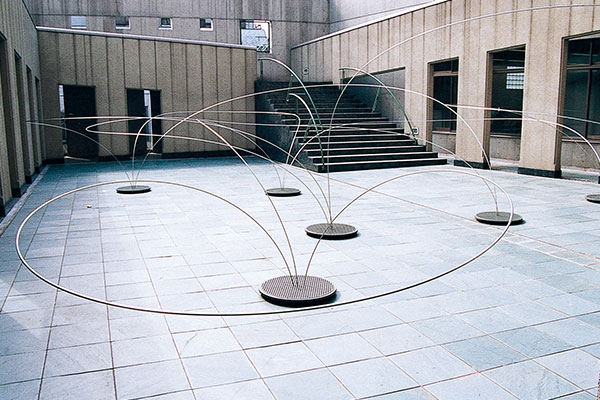
Aiko Miyawaki Utsurohi
1995, Graduate School of Mathematical Sciences
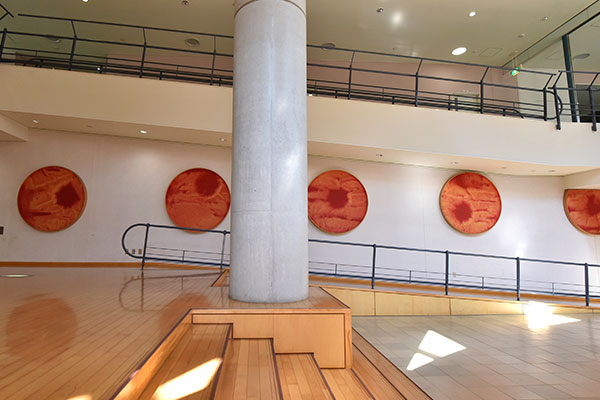
Shigeko Hirakawa Five Red Spheres
1999, Graduate School of Mathematical Sciences
The signature work of an artist who shook the art world
- Miura 12 is the signature work of Marcel Duchamp. Of the three replicas that were produced from the original, which is housed in the Philadelphia Museum of Art, this is the third, the “Tokyo version.” It was proposed by the art critic Shuzo Takiguchi and produced by the University of Tokyo in partnership with Tama Art University. The story goes that Takiguchi had promised Duchamp before he died that he would produce a replica, which is why Duchamp’s widow gave her permission.
- ―― I have absolutely no idea how to look at this.
- Miura Interpretation is left to the viewer. Although the artist left behind conceptual notes, they are not entirely consistent with the work itself.
- Kajiya It is generally accepted that the lower half represents the Bachelors’ domain, while the upper half represents the Bride’s domain; that although the Bachelors’ desires are directed at the Bride above, they are ultimately never consummated.
- Miura You could say that the main theme has to do with the barrenness of sexual love.
- Kajiya The desires of the Bachelors, expressed in the “malic molds” in the lower left, fall through the conical sieves then rise from the oculists’ charts on the right, leaving behind the traces of the “shots” in the upper half. The “capillary tubes,” “shots,” and “air current pistons” all involve the use of contingency.
- Miura The original work has large cracks in it. Although these occurred accidentally when the work was being transported, Duchamp was apparently delighted at how they served to complete the work. The idea was that he wanted to minimize the intention of the artist by incorporating contingent elements.
- ―― I suppose it really is a difficult piece.
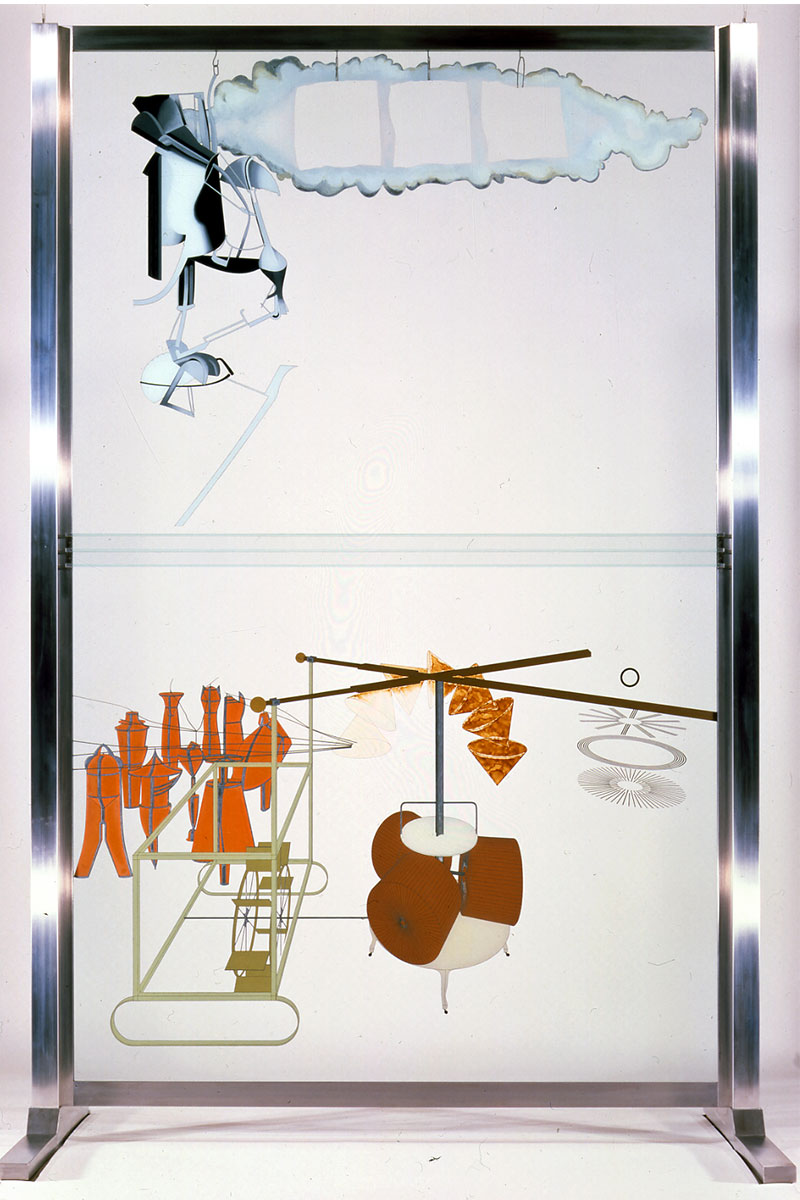
Marcel Duchamp
The Bride Stripped Bare by Her Bachelors, Even (also known as The Large Glass)
1980, Komaba Museum
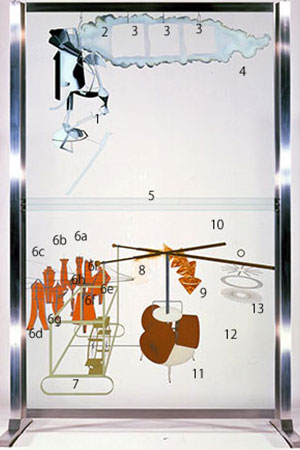
1. The Bride / Pendu femelle (“hanged female corpse”)
2. Milky Way / Top inscription
3. Air current pistons
4. (Traces of the) Nine shots
5. Bride’s garment / Horizon
6. The Bachelors – the Nine Malic Molds, forming the cemetery of uniforms and liveries a) priest; b) department-store delivery boy; c) gendarme; d) cuirassier (cavalryman); e) policeman; f) undertaker; g) flunky (liveried servant); h) café busboy; and i) stationmaster
7. Water mill wheel with glider
8. Capillary tubes
9. Sieves
10. Scissors
11. Chocolate grinder
12. Toboggan (incomplete element)
13. Oculist witnesses / oculist charts / mandala (magnifying glass)
Nihonga’s skillful assimilation of Western painting
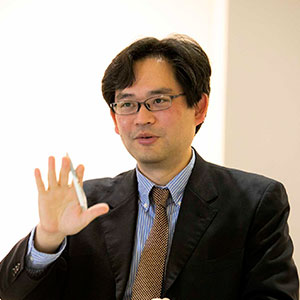
- Miura 13 is a piece that I would like to emphasize. At the end of the nineteenth century, the First Higher School under the old education system purchased about thirty works of modern Nihonga (Japanese-style painting) as teaching materials for historical and ethical education, and this work by Hashimoto Gaho is one of those. Following the teachings of Ernest Fenollosa and Okakura Tenshin, Gaho created a new style of Nihonga painting that incorporated Western influences. As one of the first professors at the Tokyo Academy of Fine Arts, he also taught figures such as Yokoyama Taikan and Hishida Shunso. This picture hints at the policy adopted by Fenollosa and his colleagues of attempting to incorporate the inspiration of Western-style painting in order to rejuvenate modern Japanese-style painting, such as through spatial representation featuring perspectival depth, chiaroscuro, and the photorealistic depiction of objects. With the support of the Ishibashi Foundation, the restoration of the entire modern Nihonga collection was completed in 2018.
- Takagishi The motif of the painting is a famous verse by the poet Saigyo, “Kokoro naki / mi ni mo aware wa / shirarekeri / shigi tatsu sawa no / aki no yugure [One without feelings / yes, even he, / knows melancholy; / snipe rising from a marsh / at dusk in fall.]” The marsh from which the snipe take wing is in what is now the Shonan area. This is a work in which Western-style painting techniques are applied to the Saigyo Monogatari Emaki [Illustrated Scrolls of the Tale of Saigyo].
- ―― The figure has a remarkably small face, doesn’t he.
- Takagishi That’s the Western style. The same is true of the aerial perspective used for the way the haze has set in. On the other hand, having the figure in the right foreground with the water’s surface on the left and the space receding off into the left side is a composition we often find in Japanese folding screens or illustrated scrolls. The composition is skillfully accomplished.
- Miura That the figure is so big is also characteristic. If this were an older Nihonga painting, he would have been drawn much smaller.
- Takagishi Drawing the human figure so large relative to the canvas emphasizes the sense of perspective. This is a way of drawing that we see in Western historical paintings.
- Miura The exquisite blend of Nihonga and Western painting styles almost shines, doesn’t it.
- Kajiya Rieko Hidaka started out as a Nihonga painter, and 14 is also painted with natural mineral pigments on paper. She depicts the sensation of feeling engulfed when looking up at the tree canopy, complementing the trees in neighboring Yanaihara Park.
- Miura The images give the sense that nature has been brought into the “forest of books” that we call a library.
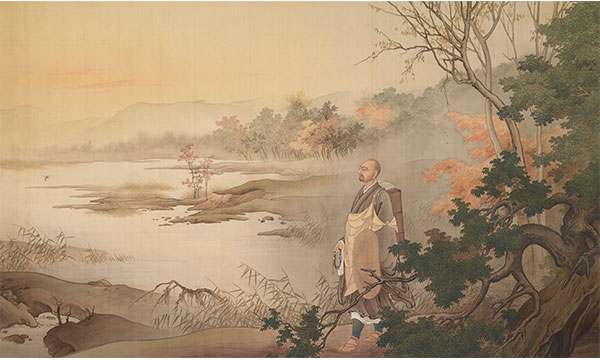
Hashimoto Gaho
Portrait of Saigyo Hoshi
1892 (Year of acquisition), Komaba Museum
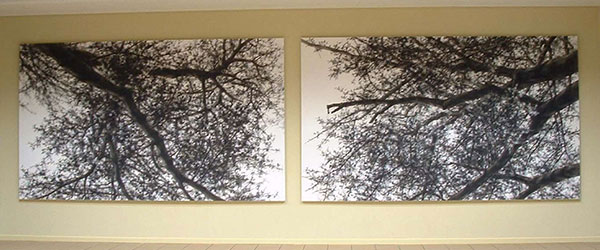
Rieko Hidaka
From the Space of Trees V
1998, Komaba Library
A surprisingly attractive large mural at Komaba
- Miura Next, 15 is a huge mural representative of the Komaba Campus. The artist, Kazuma Imazeki, became a painter after dropping out of his studies at the First Higher School. He created the painting to decorate the Komaba Library in 1969 after he returned to Japan from Europe. It is not far off the group composition one finds in the academism of nineteenth century France and is reminiscent of classic historical painting styles. The positioning of human figures in pyramid shapes is applied to both the whole and its parts, which maintains a visual order despite the large number of people. The briefs and leotards strike a discordant note, don’t they? In the West, these figures would have been painted as nudes. I suppose that since the painting was to be hung at a university, the artist eschewed nakedness in favor of representing the healthy image of calisthenics.
- Kajiya With the figures riding white horses, there’s a sense of the fantastic. I would say the hint of anachronism actually makes it more interesting.
- ―― It reminded me of the ironic “so lame it’s cool” sensibility in DA PUMP’s song “U.S.A.”
- Kajiya Oh, really? (laughs)
- Miura Actually, when I saw this painting when I was first admitted as a student, I remember feeling out of my depth. The way that it presented an extreme idealization of adolescence.
- Kajiya 1969 was a time when the student movement was at its height. The figure taking a knee in the center looks to be reading out something, to which the figure on his left seems to be swearing an oath.
- Miura It’s unfortunate that Imazeki is no longer with us so that we cannot ask him about his actual intentions.
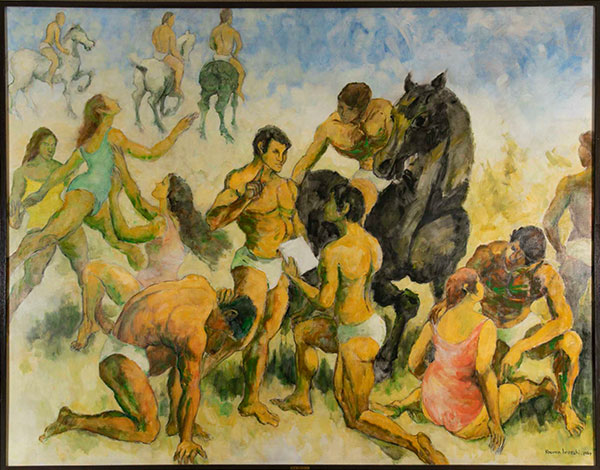
Kazuma Imazeki
Seishun [Adolescence]
1969, Komaba Faculty House
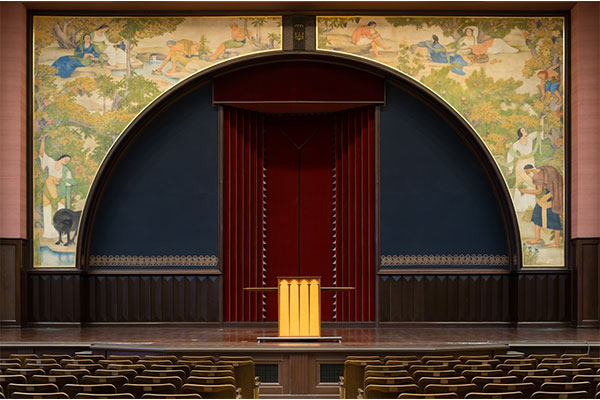
Kosugi Misei
Yusen and Saika [Wellspring and Harvest]
1925, Yasuda Auditorium
Marvelous murals at a historic university
- Miura The murals in 16 are a hallmark of the University of Tokyo. Historic universities should have marvelous murals, like for example how the Sorbonne has The Sacred Grove, Beloved of the Arts and Muses, a mural by Pierre Puvis de Chavannes. Kosugi had traveled to Paris and regarded Chavannes as one of the great painters. So the idea was undoubtedly on his mind. I feel that Yusen [Wellspring] represents matriculation and Saika [Harvest] graduation. By encountering scholarship, a spring of knowledge wells forth, and learning various things leads ultimately to harvesting the fruits thereof. The composition situates the human figures in the context of nature, which I believe he considered an appropriate motif for a university. Despite the difficulties entailed by painting on an irregularly shaped canvas, the artist has brought everything together skillfully.
- Kajiya These have also been restored.
- Miura Although the murals didn’t attract much attention during the twentieth century, they were restored after they finally started to attract interest. I hope they continue to be appreciated in the future.
- Takagishi 18 is quite unusual in that it is painted with oils on copper plate. When Francis Xavier and his missionary colleagues came to Japan, they trained Japanese boys in their teens as painters to create icons for use in their proselytism, and Jacob Niwa was one of these. He would have started by learning Western techniques of representing shadow and three-dimensional forms, and it seems he absorbed these techniques wonderfully.
- Miura With this portrait of Jesus Christ, it’s startling that a Japanese youth from that time could have painted with such accomplishment.
- Takagishi Ultimately, even these techniques were lost with the expulsion of Christianity by the Tokugawa shogunate. Thus, this kind of painting style would have existed in Japan for no more than a few decades. Apparently, the facial expression here is said to be gentler than in the Western print that was used as a model.
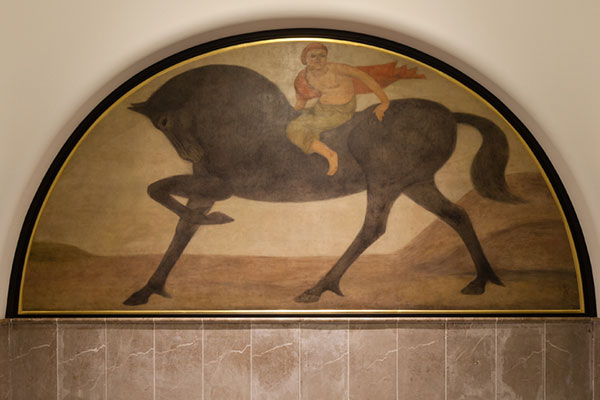
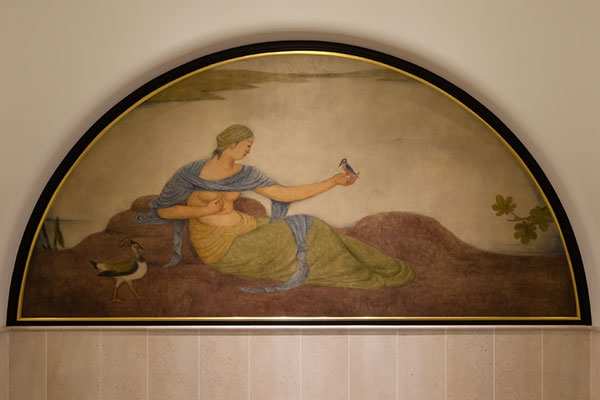
Kosugi Misei
Doi and Joi [Movement and Stillness]
1925, Yasuda Auditorium
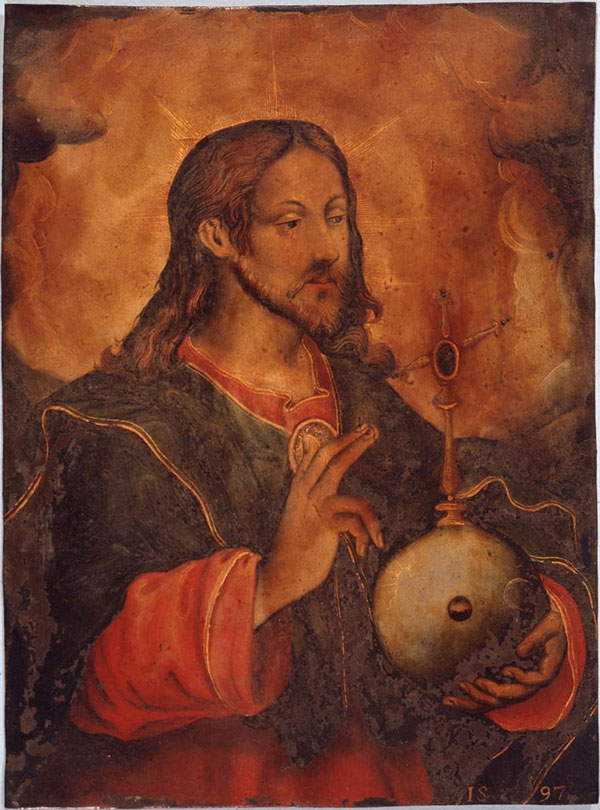
Jacob Niwa
Salvator Mundi
Undated, General Library
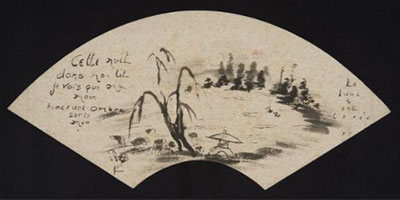
Paul Claudel
Chiketsu-shu [Poems from Pheasant Bridge]
1926, Graduate School of Humanities and Sociology
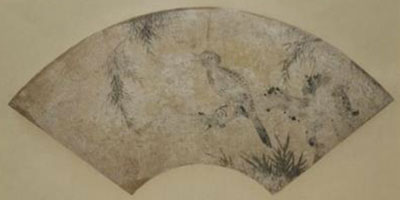
Seal imprint “Motohisa”
Fan painting of a willow with brown-eared bulbul birds
Muromachi period (1336–1573), Graduate School of Humanities and Sociology
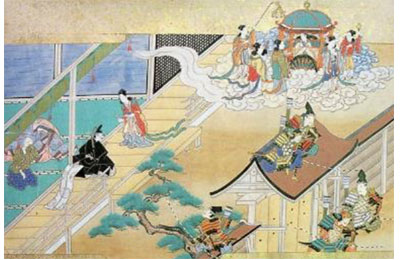
Sumiyoshi Jokei and Sumiyoshi Gukei
Episode of the Ascension of Princess Kaguya, from the Taketori Monogatari emaki [Illustrated Scrolls of the Tale of the Bamboo Cutter]
1649, Graduate School of Humanities and Sociology
Treasured paintings inherited by the Faculty of Letters
- Takagishi 19 is from the collection of UTokyo’s Department of French Language and Literature.
- Miura This is from a poetry collection edited in Tokyo by the twentieth-century French poet and playwright Paul Claudel, illustrated with pictures by the painter Tomita Keisen. Claudel had been posted to Japan as the French ambassador and was very well versed with Japanese culture. He was also interested in haiku poetry and wrote French poetry that incorporated haiku. While this is one of a limited printing of 240 copies, Claudel’s handwritten text is integrated with Keisen’s brushwork to create a singular world.
- Takagishi The painter attributed as “Motohisa” according to the seal on 20 was likely a disciple or relative of Kano Motonobu. In the first half of the sixteenth century, the Kano school produced these handheld fans in significant numbers in an enormous workshop, selling them under the Kano brand by impressing them with their official seals. This is one of those, a fan that would have originally been attached to a folding screen (byobu). They were often painted as suiboku-ga (ink wash paintings), and here the softness of the willow and downy texture of the birds’ wings come across quite well. 21 was created by two artists, Sumiyoshi Jokei and Sumiyoshi Gukei. The Sumiyoshi school were disciples of the Tosa school; they were orthodox painters that served the family of the ruling shoguns. Prior to twenty or thirty years ago, illustrated scrolls from the Edo period were not very highly regarded by art collectors, and were chiefly purchased as research materials by scholars of Japanese literature. At the time it was acquired, this piece would not have been recognized as having much value. Nevertheless, this has been re-evaluated over the last ten years. Its presence in the Department of Japanese Literature rather than Art History is a historical tale in itself.
- Kajiya 22 is an album of prints published to commemorate the University of Tokyo’s centennial in 1977. It contains ten works that convey the appearance of Hongo and Komaba in the 1970s.
- Miura Iwao Miura studied in the Department of Oriental History in the Faculty of Letters. He won the silver medal at a Parisian Salon Exhibition for a work entitled Yakushi-ji no To [The Pagoda at Yakushi-ji Temple] in 1970, and the gold medal for Pari Fukei [Paris Landscape] in 1971. He was active as a watercolor artist in both Japan and France.
- Takagishi We see the landscape as it was before all of the high-rise buildings were built on campus. The works are redolent of an era of restored peace after the conflicts that had swept the University of Tokyo.
- Miura It’s not only the buildings; the paintings have all been accomplished with a gentility that always includes greenery, that is free from any unpleasantness.
- Takagishi They do have something of the look of picture postcards, but I think we can see that as a good thing.
- Miura There’s an anecdote about how Yajuro Takashima, the painter of 23 and 24, refused to accept the silver watch that he was eligible to receive upon graduating at the top of his class from the Department of Fisheries in the Faculty of Agriculture. He lived as a solitary painter without any connection to painting circles, but his work has recently been the subject of ongoing re-evaluation. He is most famous for his paintings of candles, but his style of painting is extremely realistic and mysterious, even spiritual. Apparently, this is rooted in the Buddhist idea of mercy. I can’t think of very many painters who evoke religiosity in their depictions of nature. With these paintings, too, one is drawn in by looking at them.
- ―― Apparently these works were donated by the artist in connection with his being admitted to the University Hospital attached to the Institute of Medical Science.
- Miura What a wonderful gift!
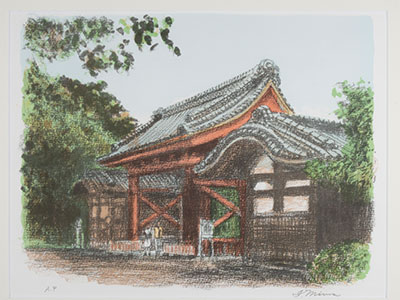
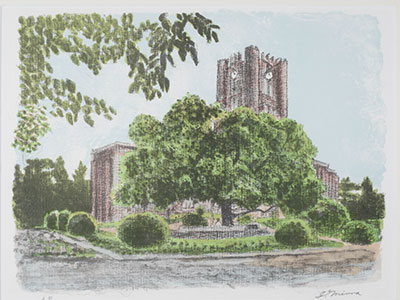
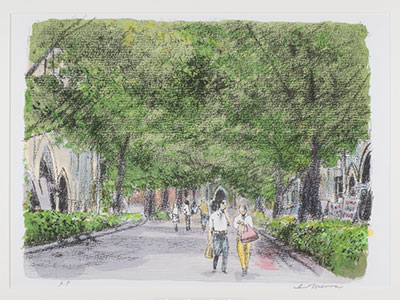
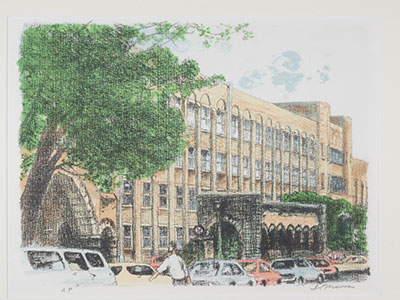
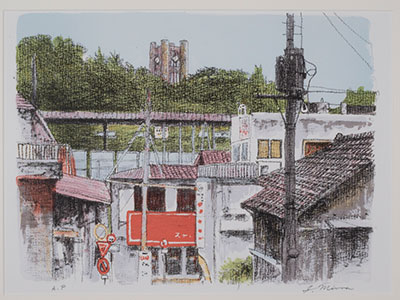
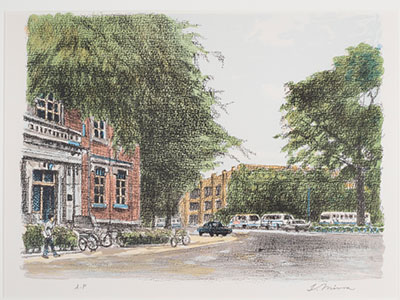
Tokyo Daigaku Sekibanga-shu [Commemorative Album of Lithographs of the University of Tokyo]
1977, Administration Bureau Building
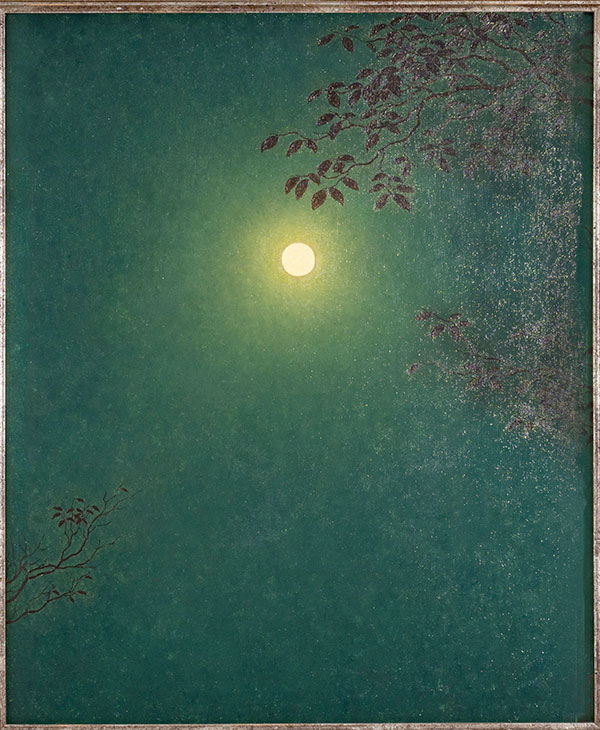
Yajuro Takashima
Mangetsu [Full Moon]
1963, Institute of Medical Science
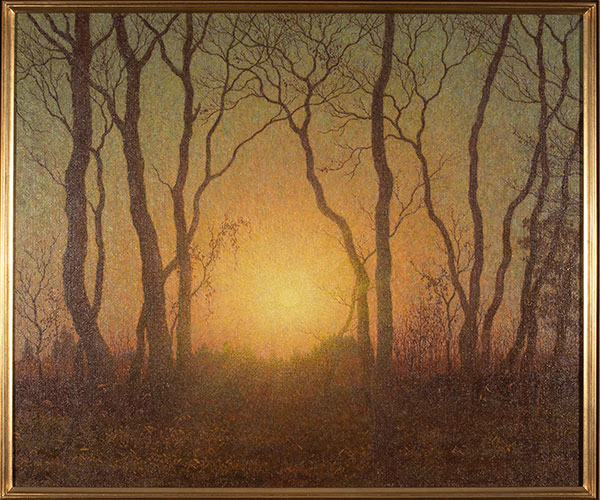
Yajuro Takashima
Rinben Taiyo [Sun at the Forest Margin]
Circa 1967, Institute of Medical Science
Securing the legacy of works associated with the University of Tokyo for posterity
- ―― So, do you have any more thoughts on what we have seen so far?
- Miura We have more works of art by people associated with the University of Tokyo than I’d have thought. I hope that we continue to cherish works like this, which have come into the University’s possession via such connections.
- Kajiya Also, a not insignificant number of them were acquired for the purpose of teaching and research. I still want to know about how much art we are taking in. That said, I’m aware that some other universities house more extensive collections.
- Takagishi Yes, the collections at universities like Princeton, Harvard and Yale could be considered at the level of major art galleries. Chronologically and systematically speaking, these places apparently have a longstanding strategy of collecting pieces in the styles that they are lacking.
- Miura And they are backed by powerful financial support.
- Takagishi Many of the works at the University of Tokyo, even those that were not collected out of an aesthetic motivation, are being re-evaluated, one after another. That makes me hopeful. It seems likely that there will surely be other things that, though they are not in the limelight now, will come to be more favorably evaluated in the future. Professor Naoyuki Kinoshita has been turning up objets d’art one after another on campus, and I hope that those of us who follow him will be able to take over that project and cultivate it further.
- Miura Normally, interest is oriented toward things that have value at the present moment. Since universities are not constrained by those values, this might be a good idea.
- Takagishi This is the benefit of collecting without the desire for gain. Even so, we cannot allow works to be lost or damaged as the result of this lack of avarice.
- Kajiya Thinking this way emphasizes once again how unfortunate it was that we lost Kizuna. It was an extremely important work in terms of thinking about postwar Japanese art.
- Miura In the future, it may not be a bad thing for the University to be a bit more avaricious. Moreover, I would like for us to strive to reinvest that value into our teaching and research.
- (January 18, 2019, at the Komaba Museum)
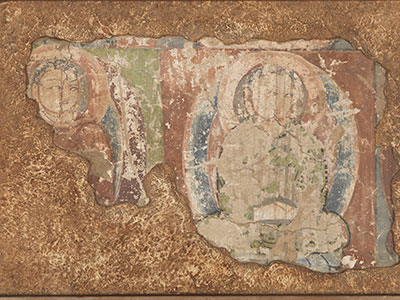
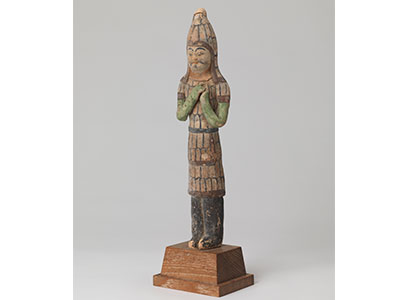
Warrior Statue
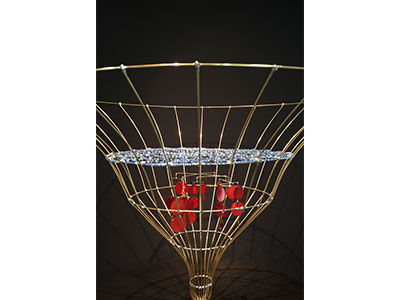
Uchu Bocho Shinka no Shikaku Dentatsu Sochi:
Biggu-ban to Uchu no Hareagari [An installation visualizing the expansion and evolution of the universe: Big Bang and the Recombination Epoch]
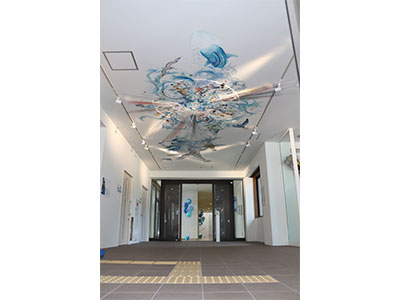
Umi no Tenjo-ga / Seimei no Akiperago [Ceiling Mural of the Ocean / Archipelago of Life]
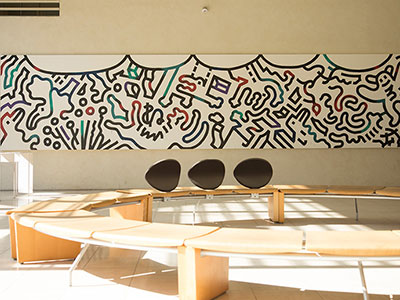
16×9 Burajiru no Oto [16x9 The Sound of Brazil]
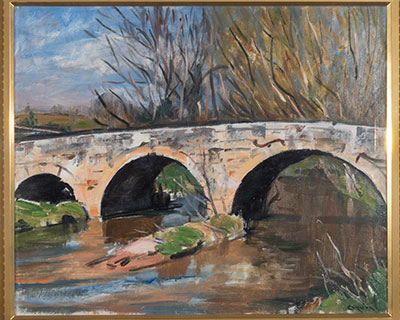
Burugonyu no Furuhashi [Old Bridge of Burgundy]
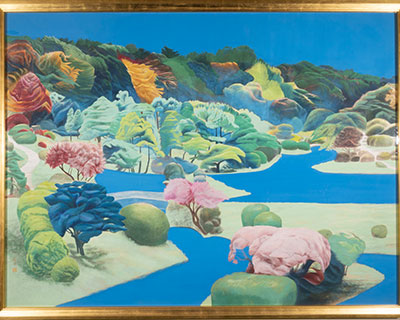
Nyuton no Ringo [Newton’s Apple]
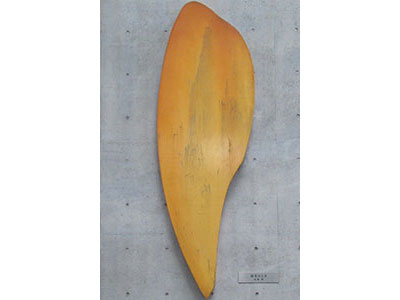
Hoga no Toki [Time of Portent]
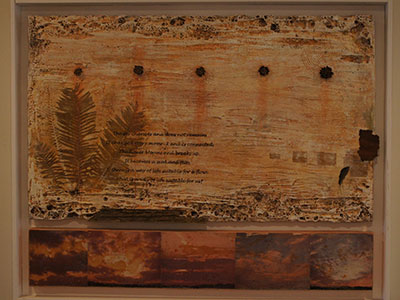
Kawaritsuzukeru Mugen to Sono Kakera 05 [Ever-changing Infinity and Its Fragments 05]
25. Fragment of a depiction of one thousand Buddhas in the same shape and size from a temple mural. The side-glancing expressions are a defining feature. Excavated from a site in Hotan, Xinjiang Uyghur Autonomous Region, China / Reputedly collected by Albert von Le Coq / circa 7th century / Institute for Advanced Studies on Asia
26. A human effigy unearthed from a burial mound at the ancient kingdom of Gaochang. Made from a piece of wood wrapped with clay. Excavated near Turpan in China’s Xinjiang Uyghur Autonomous Region / Reputedly collected by the Otani Expedition / Tang dynasty (8th century) / Institute for Advanced Studies on Asia
27. A wireframe artwork representing the birth and expansion of the universe. Available for viewing on the 1st floor of the Faculty of Science Building No. 1. 2011 / Graduate School of Science
28. A whale, sea turtles and black-tailed gulls… Find the sea, the source of all life, at the entrance of the new building of the Center in Otsuchi, Iwate Prefecture. 2018 / International Coastal Research Center, Atmosphere and Ocean Research Institute
29. The bottom part of a conceptual drawing on six canvases of the interior of the robes of the statue of Christ the Redeemer in Rio de Janeiro. The five curved lines at the top represent Christ’s toes. Research Center for Advanced Science and Technology.
30. A work created and donated by a painter who was active in France in honor of the recognition of Professor Hiroshi Inose (1927–2000) as a Person of Cultural Merit. 1986 / Sanjo Conference Hall
31. A work painted for the President’s Reception Room on the theme of the graft from Sir Isaac Newton’s apple tree in the Koishikawa Botanical Garden. 2003 / Sanjo Conference Hall
32-33. Four works by Osamu Kato and two by Ai Sato on display in the building and on its exterior walls. There are also three works by Hiroko Ohno, the artist behind 31. / Institute for Solid State Physics
|
Materials for teaching painting and sculpture from the Kobu Bijutsu Gakko period 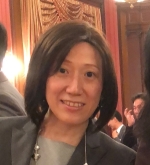
By Mayumi Tsunoda Perhaps you have heard of the Kobu Bijutsu Gakko (the “Technical Fine Arts School”), the first educational institution to teach Western art in Japan. As a matter of fact, the teaching materials that belonged to the Kobu Bijutsu Gakko have been inherited by the Department of Architecture in the University of Tokyo’s Graduate School of Engineering. The establishment of an institutional base for the teaching of modern engineering was advocated by Hirobumi Ito and Yozo Yamao, who had witnessed firsthand the situation in Great Britain after the Industrial Revolution. In answer, a technical school (later the Kobu Daigakko, or Imperial College of Engineering) was opened in 1873 as an institutional base for engineering education in the Engineering Institution (Kogakuryo), an executive arm of the Ministry of Public Works (Kobu-sho). Meanwhile, a school of fine art (later the Kobu Bijutsu Gakko) was also founded within the Engineering Institution in 1876 in order to bring the “technologies of European modernity” to “the aid of myriad industries.” Whereas the technical school was staffed exclusively by British instructors, Italian instructors were brought in for the opening of the school of fine art. In January of 1877, after the Ministry of Public Works Engineering Institution was brought under the jurisdiction of the Building and Manufacturing Bureau (Kosaku-kyoku), the school’s name was changed to the Kosaku-kyoku Bijutsu-ko (“Building and Manufacturing Bureau School of Art”), and then again in June to the Kobu Bijutsu Gakko. Nevertheless, a variety of circumstances conspired with the result that the initial vision for the school never came to fruition; the final cohort of students in the sculpture course graduated or completed their studies in 1882, and the school was closed after students in the painting course completed their studies the following year in January 1883. In response to the school’s closure, the teaching materials and other works produced at the Kobu Bijutsu Gakko were transferred to the Kobu Daigakko, which was then also a part of the Ministry of Public Works. These materials came under the management of the Department of Construction (later the Department of Architecture) of the Kobu Daigakko’s successor, the College of Engineering (also known as the Koka Daigaku), and even today remain in the collection of the Department of Architecture in the Graduate School of Engineering at the University of Tokyo. Turning to some of the specific materials, those dedicated to the teaching of sculpture include not only plaster busts brought from Italy, but also works such as Mrs. Keller and Bust Relief in Octagonal Frame by the foreign instructor Vincenzo Ragusa, Ariadne: a European Woman by Reiyu Oguri, who was a student at the college, and Jailbreak (modeled after Vela’s Spartacus), a graduation piece by Ujihiro Okuma, who later gained renown for his bronze statue of Omura Masujiro at Yasukuni Shrine. Also, with regards to educational materials from the painting department, in addition to illustrations and anatomical drawings that were used as models for copying, the collection includes pieces like the Conté crayon illustration Kyujutsu no Zu (Archery Study) by Sachihiko Soyama, who worked at the Imperial College of Engineering’s museum after the closure of the Kobu Bijutsu Gakko and later taught freehand painting at the Department of Construction at the College of Engineering. In addition to being highly regarded as works in their own right, these collections are also extremely valuable primary historical materials for understanding the era of the reception of Western art education in Japan, and have been widely featured in many magazines, television programs and exhibitions. Currently, the Department of Architecture has established a “Digital Museum” preparation office where, in addition to these teaching materials from the Kobu Bijutsu Gakko, we are moving ahead with the release of teaching materials from the Department of Construction in the Imperial College of Engineering, including from the later period after it was renamed the Department of Architecture in the College of Engineering. |
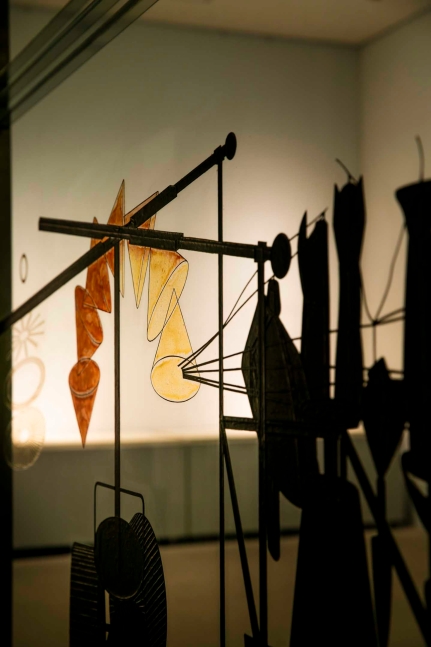
The back side of The Large Glass by Marcel Duchamp Popularly known as The Large Glass, this work, which Duchamp labored on for eight years from age 28 to 36, was abandoned without bringing it to completion. When it was damaged in shipping after being shown in an exhibition in 1926, Duchamp himself repaired it in 1936. The official name is La mariée mise à nu par ses célibataires, même (English: The Bride Stripped Bare by Her Bachelors, Even). Many of the color portions use lead foil to prevent degradation of the paint, and from the rear, only the outlines can be seen. The sieve portion, however, does not use lead and the color gradations can be seen even from the back side. The back and front of this work, considered a monumental accomplishment of 20th century art, can be viewed free of charge at the Komaba Museum on UTokyo’s Komaba Campus (open from 10:00 a.m. to 6:00 p.m. weekdays). (http://museum.c.u-tokyo.ac.jp/) |
* This article was originally printed in Tansei 38 (Japanese language only). All information in this article is as of March 2019.






